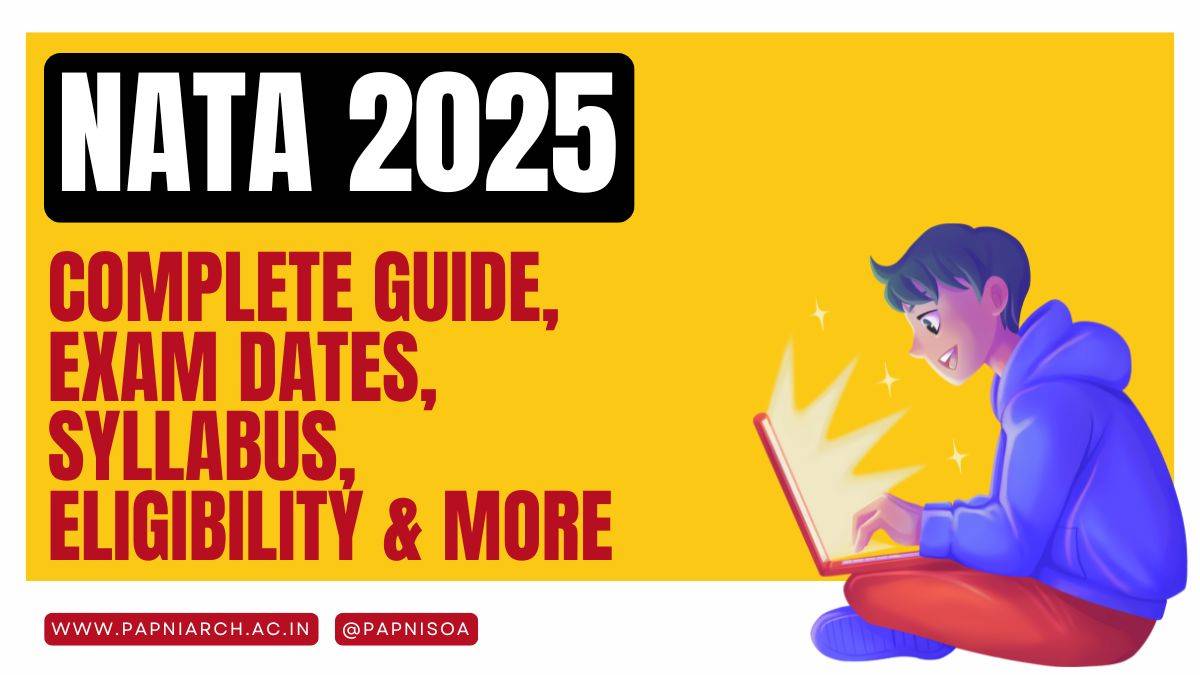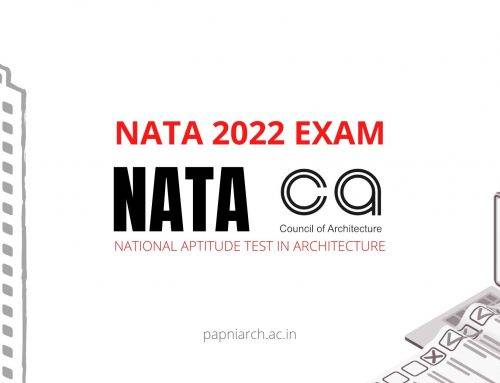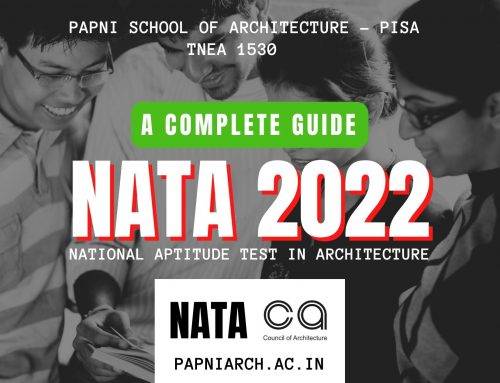- PISA - PAPNI SCHOOL OF ARCHITECTURE
- What is NATA and Why is it Important?
- NATA 2025: Key Highlights
- Eligibility Criteria: Are You Eligible for NATA 2025?
- NATA 2025 Exam Pattern: A Two-Part Assessment
- NATA 2025 Syllabus: What to Expect
- Application Process: Step-by-Step Guide
- NATA 2025 Exam Dates and Schedule
- Appointment Card (Admit Card)
- Test Centres
- NATA 2025 Results
- Appearing for Multiple Attempts
- NATA Score Validity
- Exam Day Tips
- Frequently Asked Questions (FAQs)
- Conclusion
- Related Posts
- PISA - Papni School of Architecture
Are you dreaming of a career in architecture? The National Aptitude Test in Architecture (NATA) 2025 is your first step towards achieving that dream. This comprehensive guide provides everything you need to know about NATA 2025, from eligibility and syllabus to the application process and exam day tips.
What is NATA and Why is it Important?
NATA is a national-level entrance examination conducted by the Council of Architecture (CoA). It’s a mandatory requirement for admission to the 5-year Bachelor of Architecture (B.Arch.) degree program in all CoA-recognized institutions across India. NATA isn’t just another exam; it’s designed to assess your aptitude for architecture – your innate abilities in areas like:
Visual Reasoning: How well you understand and interpret visual information, including 2D and 3D compositions.
Logical Derivation: Your ability to solve problems logically and draw conclusions from given information.
G.K., Architecture & Design: Your general awareness of architecture, important buildings, design principles, and current trends in the field.
Language Interpretation: Your understanding of English grammar and ability to interpret the meaning of words and sentences.
Design Sensitivity and Thinking: Your ability to analyze design elements, understand spatial relationships, and think critically about design problems.
Numerical Ability: Your grasp of basic mathematical concepts and their application to architectural design, particularly geometry.
NATA doesn’t test your memorized knowledge of specific subjects. It evaluates your inherent potential to succeed in the challenging and creative field of architecture.
NATA 2025: Key Highlights
Conducting Body: Council of Architecture (CoA)
Exam Mode: Part A (Drawing – Offline), Part B (MCQ/NCQ – Online Adaptive)
Exam Dates: Fridays and Saturdays, from March 1st, 2025, to June 2025.
Exam Duration: 3 hours for each session (Part A: 90 minutes, Part B: 90 minutes).
Total Marks: 200 (Part A: 80, Part B: 120)
Medium of Exam: English and Hindi
Official Website: www.nata.in
Eligibility Criteria: Are You Eligible for NATA 2025?
There are two levels of eligibility to consider:
1. Eligibility to Appear for NATA 2025:
You must have passed or be appearing in one of the following:
10+1 Examination with Physics, Chemistry, and Mathematics (PCM).
10+2 Examination with PCM.
10+3 Diploma Examination with Mathematics as a subject.
2. Eligibility for Admission to B.Arch.:
Meeting the above criteria allows you to take the NATA exam. However, to be admitted to a B.Arch. program, you must meet the following requirements set by the CoA:
Passed 10+2 or equivalent with Physics and Mathematics as compulsory subjects, along with either Chemistry, Biology, Technical Vocational subject, Computer Science, IT, Informatics Practices, Engineering Graphics, or Business Studies, with at least 45% marks in aggregate.
ORPassed a 10+3 Diploma Examination with Mathematics as a compulsory subject, with at least 45% marks in aggregate.
AND you must have a valid NATA score.
Important Note: Qualifying in NATA does not guarantee admission. You must also fulfill the specific requirements of the institution you’re applying to.
NATA 2025 Exam Pattern: A Two-Part Assessment
NATA 2025 consists of two parts:
Part A: Drawing and Composition Test (Offline) – 80 Marks
Duration: 90 minutes
Format: Offline, paper-based drawing test.
Questions: Three questions assessing different aspects of drawing and composition.
A1: Composition and Color (25 Marks): Creating visually appealing compositions and coloring them appropriately.
A2: Sketching & Composition (Black and White) (25 Marks): Drawing scenarios involving buildings, people, environments, and objects, demonstrating an understanding of scale, proportion, and perspective.
A3: 3D Composition (30 Marks): Creating three-dimensional compositions using provided materials, showcasing your spatial reasoning and design skills.
Part B: MCQ and NCQ (Computer-Based Adaptive Test) – 120 Marks
Duration: 90 minutes
Format: Online, computer-based test.
Questions: 50 questions, divided into:
B1: Multiple Choice Questions (MCQ) – 42 Questions
B2: No Choice Questions(NCQ) – 8 Questions
Total time for each question: 108 Seconds.
Topics Covered:
Visual Reasoning
Logical Derivation
G.K., Architecture & Design
Language Interpretation
Design Sensitivity and Thinking
Numerical Ability
What are NCQ Questions?
NCQ, or No Choice Questions, are questions where you won’t be given multiple-choice options. Instead, you might need to:
Type in a numerical answer.
Perform a specific task on the computer (e.g., manipulating a shape, drawing a line).
Provide a short, typed response.
These questions test your ability to apply your knowledge and skills directly, rather than simply selecting from pre-defined answers.
NATA 2025 Syllabus: What to Expect
While NATA doesn’t have a prescribed syllabus in the traditional sense (it tests aptitude, not memorized facts), understanding the areas assessed is crucial. Here’s a breakdown:
Part A (Drawing and Composition):
Understanding of Scale and Proportion: Drawing objects and scenes accurately, maintaining correct proportions.
Geometric Composition: Using geometric shapes to create balanced and visually appealing compositions.
Shape, Form, and Building Forms: Understanding and representing different shapes and forms, including architectural elements.
Aesthetics, Color Texture, Harmony, and Contrast: Applying principles of design to create visually pleasing drawings.
Conceptualization and Visualization: Translating ideas and concepts into visual representations.
Drawing of Patterns – Both Geometrical and Abstract: Creating and replicating patterns.
Creating 2D and 3D Compositions: Using given shapes and forms to create compositions in both two and three dimensions.
Perspective Drawing: Drawing objects and scenes with accurate perspective.
Sketching of Urbanscape and Landscape: Drawing cityscapes and landscapes, capturing the essence of the environment.
Common Everyday Objects: Drawing familiar objects from memory, demonstrating observation skills.
Part B (MCQ and NCQ):
Visual Reasoning: Analyzing visual information, identifying patterns, and understanding spatial relationships.
Logical Derivation: Solving problems using logical reasoning and deduction.
G.K., Architecture & Design: Questions related to famous architects, important buildings, architectural styles, design principles, and current trends in architecture and design.
Language Interpretation: Understanding English grammar, vocabulary, and the meaning of sentences and passages.
Design Sensitivity and Thinking: Analyzing design problems, understanding user needs, and evaluating design solutions.
Numerical Ability: Applying basic mathematical concepts (arithmetic, algebra, geometry, trigonometry) to solve problems related to architectural design.
Application Process: Step-by-Step Guide
Visit the NATA Website: Go to the official NATA website: www.nata.in.
Create an Account: Register on the portal by providing your details and creating a username and password. Remember your login credentials!
Fill out the Application Form: The online form is divided into three sections:
Personal Details: Enter your personal information accurately. Fields marked with an asterisk (*) are mandatory.
Document Uploading: Upload scanned images of your photograph and signature, adhering to the specified size and format requirements:
Document Minimum Size Maximum Size Height Width Photograph 4 KB 100 KB 4.5 cm 3.5 cm Signature 1 KB 30 KB 1.5 cm 3.5 cm Fee Payment: Pay the application fee online using a debit card, credit card, or net banking. The fee varies based on your category:
Category Fee (in India, INR) Fee (Outside India, INR) General/OBC (NCL) 1750 15000 SC/ST/EWS/PwD 1250 Transgender 1000 Per test.
Review and Submit: Carefully review all the information you’ve entered before submitting the form.
Print Confirmation Page: After successful fee payment, a Confirmation Page will be generated. Print this page and keep it safe. It’s proof of your registration. You do not need to send this page or any other documents by post.
Important Notes:
Unique Application: Your name, father’s name, mother’s name, date of birth, and postal address, taken together, must be unique for each application.
Email Verification: The system will verify your email address. Make sure you provide a valid and active email address.
Password and Security Question: Choose a strong password and a security question/answer pair for password recovery.
Correction Window: You will have one opportunity to correct any errors in your personal details during a designated correction window.
NATA 2025 Exam Dates and Schedule
NATA 2025 will be conducted on Fridays and Saturdays, starting from March 1st, 2025, until June 2025. The specific exam dates and sessions will be announced on the NATA website. Here’s the general schedule:
| Day | Session | Time |
| Fridays | Afternoon Session | 1:30 PM to 4:30 PM (3 hours) |
| Saturdays | Morning Session | 10:00 AM to 1:00 PM (3 hours) |
| Saturdays | Afternoon Session | 1:30 PM to 4:30 PM (3 hours) |
Appointment Card (Admit Card)
After you register, an Appointment Card (which serves as your admit card) will be generated. It will contain:
Your allotted Test Centre.
The exam session (morning or afternoon).
Your appointment number.
You must download and print the Appointment Card from the NATA website. Bring the printed card and a valid photo ID to the Test Centre on the day of the exam.
Test Centres
NATA 2025 will be conducted in various cities across India, as well as one international center in Dubai. You can choose your preferred city/region during the application process, but the final allocation of the Test Centre is at the discretion of the CoA.
NATA 2025 Results
The results of NATA 2025 will be declared on the official NATA website (www.nata.in). To qualify, you need to score:
A minimum of 20 marks in Part A (Drawing and Composition).
A minimum of 30 marks in Part B (MCQ and NCQ).
An overall score of at least 70 out of 200.
If you take multiple attempts, your best score will be considered.
Appearing for Multiple Attempts
You can take NATA 2025 up to three times. If you appeared for NATA 2024 and also appear for NATA 2025, the following rules apply:
| NATA 2024 Status | NATA 2025 Attempts | Final Score Used |
| Valid 2024 Score | 1st Attempt | Better of NATA 2024 and NATA 2025 scores |
| Valid 2024 Score | 1st & 2nd Attempt | Best of the three scores (NATA 2024 and two NATA 2025 attempts) |
| Valid 2024 Score | 1st, 2nd & 3rd Attempt | Best of the three NATA 2025 scores (NATA 2024 score becomes invalid) |
NATA Score Validity
Your NATA 2025 score is valid for one academic year only (for admissions in the 2025-2026 academic session).
Exam Day Tips
Reach the Test Centre on Time: Report to the Test Centre well before the scheduled time (as indicated on your Appointment Card).
Carry Required Documents: Bring your printed Appointment Card and a valid photo ID.
Manage Your Time: Allocate your time wisely between the two sections of the exam.
Drawing Section (Part A): Focus on accuracy, neatness, and conveying your ideas effectively. Practice drawing regularly to improve your skills.
MCQ/NCQ Section (Part B): Read the questions carefully and manage time between different sections.
Stay Calm and Focused: Avoid panicking and try to stay focused throughout the exam.
Frequently Asked Questions (FAQs)
You can contact the NATA Help Desk:
Email: stusupport@nata-app.online
Phone: 7385395400
The schedule will be available on the official NATA website (www.nata.in).
The NATA 2025 score is valid for one academic year (2025-2026 admissions).
To qualify, you need:
Minimum 20 marks in Part A.
Minimum 30 marks in Part B.
Overall qualifying marks: 70 out of 200.
Results will be declared on the NATA website (www.nata.in).
Mobile phones, calculators, electronic watches with calculator facilities, any textual material (printed or written), and any other unauthorized items are strictly prohibited.
You must bring:
Printed Appointment Card.
Original valid photo ID (Aadhaar, Passport, Driving License, Voter ID, etc.).
Pencils, erasers, dry colors, and a scale (up to 15 cm).
The Appointment Card is your admit card. It will be generated after you register and will contain details of your allotted Test Centre, session, and appointment number. You must download and print it.
No, the entire application process is online. You do not need to send any documents by post.
Yes, there will be a designated correction window during which you can make one set of corrections to your personal details.
The application fee varies based on category (check Section 7.3 in the provided content for the exact fee structure). The fee is non-refundable.
You need to upload:
A recent color passport-size photograph (with both ears visible).
Your signature.
Specific size and format requirements are provided in the application guidelines.
The application process is entirely online. Visit the NATA website (www.nata.in), create an account, fill out the application form, upload documents, and pay the fee.
NCQ stands for “No Choice Questions.” These are questions in Part B where you will likely need to type in a numerical answer or perform a specific task on the computer, rather than selecting from multiple-choice options.
The medium of the test will be English and Hindi.
Part B assesses your aptitude through:
Visual Reasoning
Logical Derivation
G.K., Architecture & Design
Language Interpretation
Design Sensitivity and Thinking
Numerical Ability
Part A assesses your drawing and composition skills through:
Composition and Color: Creating compositions and coloring them.
Sketching & Composition (Black and White): Drawing scenarios involving buildings, people, environments, etc.
3D Composition: Creating 3D compositions using provided materials.
NATA 2025 has two parts:
Part A: Drawing and Composition Test (Offline): 90 minutes, 80 marks (3 questions).
Part B: MCQ and NCQ (Computer-Based Adaptive Test): 90 minutes, 120 marks (50 questions).
Total Marks: 200
Reservation and relaxation in qualifying marks for reserved categories are determined by the Admission/Counselling Authority of the respective state/institution, not by NATA itself.
You must have:
Passed 10+2 or equivalent with Physics and Mathematics as compulsory subjects, along with either Chemistry, Biology, Technical Vocational subject, Computer Science, IT, Informatics Practices, Engineering Graphics, or Business Studies, with at least 45% marks in aggregate.
ORPassed a 10+3 Diploma Examination with Mathematics as a compulsory subject, with at least 45% marks in aggregate.
And you must have a valid NATA score.
You must have passed or be appearing in one of the following:
10+1 Examination with Physics, Chemistry, and Mathematics (PCM).
10+2 Examination with PCM.
10+3 Diploma Examination with Mathematics as a subject.
It depends on how many attempts you make in NATA 2025:
One Attempt: The better of your NATA 2024 and NATA 2025 scores will be used.
Two Attempts: The best of the three scores (NATA 2024 and two NATA 2025 attempts) will be used.
Three Attempts: Only your NATA 2025 scores will be considered (the best of the three), and your NATA 2024 score will become invalid.
No, NATA scores are valid only for the academic year in which the test is taken. If you appeared in NATA 2024 and wish to apply for admissions in 2025, you must take NATA 2025. However, if you take NATA 2025, your 2024 score may be considered
You can attempt NATA 2025 a maximum of three times within the academic year.
NATA assesses innate aptitude, which cannot be taught or learned in the traditional sense. However, familiarizing yourself with the exam pattern and practicing relevant skills (like drawing, spatial reasoning, and logical deduction) can improve your performance.
NATA assesses a candidate’s aptitude for architecture, focusing on cognitive skills, visual perception, aesthetic sensitivity, logical reasoning, and general awareness related to architecture. It’s designed to evaluate inherent abilities rather than learned knowledge.
Yes, qualifying in NATA (or JEE Paper 2 for Architecture) is mandatory for admission to B.Arch. programs in institutions recognized by the CoA. However, fulfilling NATA requirements alone doesn’t guarantee admission; you must also meet the specific eligibility criteria of the institution you’re applying to.
The Council of Architecture (CoA), a statutory body under the Ministry of Education, Government of India, conducts NATA.
NATA (National Aptitude Test in Architecture) is a national-level entrance examination conducted by the Council of Architecture (CoA) for admission to the 5-year Bachelor of Architecture (B.Arch.) degree program in recognized institutions across India.
Conclusion
NATA 2025 is your gateway to a fulfilling career in architecture. By understanding the exam pattern, eligibility criteria, and application process, and by preparing diligently, you can increase your chances of success. Remember to visit the official NATA website (www.nata.in) regularly for the latest updates and announcements. Good luck!





